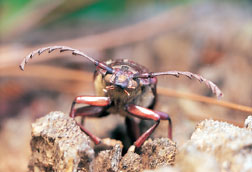Characterization of the Ashepoo-Combahee-Edisto (ACE) Basin, South Carolina
Insects
Because of their diversity and abundance, insects play major roles in the functioning of terrestrial and freshwater ecosystems. For example, insects influence the nutrient and energy flow of ecosystems in many ways, but perhaps most importantly as decomposers. No source of decaying organic material goes unused by insects, and their action is often necessary before other groups of decomposers can take advantage of the material. In both terrestrial and freshwater aquatic ecosystems, insect decomposers are crucial to the breakdown of plant material (both leaf litter and woody material), dead animals, and waste material. The decomposition of carrion is also slowed when insects are excluded from the process (Payne, 1965).
Despite the many important ways that insects influence ecosystem structure and function, we know relatively little about the insect faunas of most southeastern U.S. habitats, including those in the ACE Basin study area. Based on known and likely distributions, the ACE Basin study area should have 30 orders of insects (out of the 31 recognized in Borror et al. 1989), only lacking the Grylloblattaria, which are known only from beyond the treeline in the mountains and the arctic (Scholtens pers. comm.). Scholtens (pers. comm.) estimated that 8,000 to 10,000 insect species live in the Basin. This estimate should be considered preliminary because so few groups have been surveyed, and for those that have, there are either relatively few collections, or survey work was done outside the ACE Basin study area.

Probably the best studied taxa of insects in the ACE Basin study area and elsewhere are the butterflies and skippers (Papilionoidea and Hesperioidea). They occur in all major habitats in the ACE Basin study area, and approximately 125 butterfly and skipper species are either residents or migrants. Of the 125 butterfly and skipper species in the ACE Basin study area, 41 are classified as habitat specialists. Of these, 27 are restricted to some sort of wooded habitat and 12 to open habitats, and 2 have mixed preferences. Overall, 24 species prefer wet or moist habitats and 17 prefer dry habitats. These numbers indicate that the loss of some specialized habitats, particularly wetlands, could result in the disproportionate loss of species from two families of butterflies and skippers. For at least these insect groups, the numbers emphasize the importance of swamps, freshwater marshes, and saltwater marshes for maintaining species diversity.

For most groups of insects in most habitats, however, a great deal remains to be learned about how they influence the structure and functioning of that ecosystem. Of all habitats characteristic of the ACE Basin study area, the most is known about the community of insects found in salt marshes (Davis 1978; Davis and Gray 1966; Foster and Treherne 1976; Marples 1966; Teal 1962). Davis and Gray (1966) showed that the most abundant insects in the salt marsh are the Diptera (true flies) and Homoptera (hoppers), each with only a few common species represented. The next most abundant orders of insects are Coleoptera (beetles), Orthoptera (grasshoppers, katydids, and crickets), Lepidoptera (butterflies and moths), Hemiptera (true bugs), Hymenoptera (bees, wasps, and ants), and Odonata (dragonflies and damselflies), respectively, as well as smaller numbers of other orders. Vernberg and Sansbury (1972) found similar results in Port Royal Sound, South Carolina, and these same dominants are likely abundant throughout salt marshes in the ACE Basin study area. However, salt marsh habitat has a relatively low diversity of insects despite their high abundance.

Since no group of insects in any ACE Basin habitat has received significant attention, it is difficult to make knowledgeable decisions about how best to maintain insect diversity in the region. However, there is consensus in the field of insect conservation that the most important factor in maintaining diversity is maintaining appropriate habitat (Gaston et al. 1993; Pullin 1995). In this regard the ACE Basin study area is fortunate because large areas of habitat are already set aside as protected lands. Additional conserved areas could be advantageous in maintaining insect diversity, but decisions about which habitats are most important will have to await more complete information on occurrence and distribution of insects in the region.
